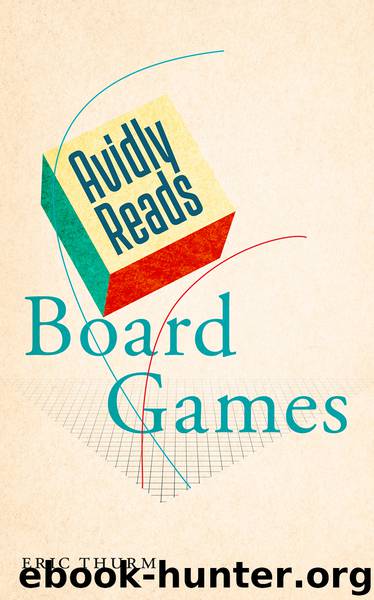Avidly Reads Board Games by Eric Thurm

Author:Eric Thurm
Language: eng
Format: epub
Tags: LCO002000 Literary Collections / American / General
Publisher: NYU Press
4
Can Friendship Be Stronger than War Games?
A given person will associate many different words with the concept of board games—childish, emotionally warm, intense, complex—but one thing they almost always are is competitive. The entire point of Monopoly is to push everyone else out of the market and become the sole property owner in town. Chess, Risk, and every other war game in history exist to model a conflict, which any given player will either win or lose. Catan, which encourages negotiation and mutually beneficial moves, ultimately forces players to act decisively on their own to end the game. Even Juden Raus asks players to compete to be the first to complete their deportation of the city’s Jewish population; the players may all have the same objective, but they’re still trying to be the best at it. Why even play a game if not to prove you’re better than the other players?
In this light, the rise of cooperative board games over the past fifteen years or so feels like a seismic shift in the medium, a sea change that might fundamentally alter the way people approach tabletop gaming. If your entire experience with board games comes from competitive games, it’s hard to imagine what this might look like—the focus, objectives, and tension of most of your game sessions comes from everyone expending energy to win at the expense of everyone else. But cooperative games create a different kind of intensity: a shared frenzy in which the entire group assembled around the table works together to take down an enemy created by the game’s rule set and achieve a shared objective.
Broadly speaking, cooperative games use cards, dice, or other rules to create an analog equivalent of a video game’s artificial intelligence, an opponent that every person assembled around the table can work against in unison. For years, the closest things got to full cooperation in traditional board games were games in which a single player was pitted against everyone else in uneven teams. Take 1983’s Scotland Yard, in which one player takes on the role of Mr. X, a fugitive from the titular law enforcement agency. Using a complicated series of bluffs, guesses, and hints, the rest of the players travel through London attempting to catch Mr. X; either Mr. X will win, or the rest of the players will. In some respects, this modeled the basic structure of role-playing games like Dungeons & Dragons, in which a party of player characters pursue their own aims while getting through the obstacles created by the Dungeon Master (DM).
All of the ogres, dragons, and evil wizards a party encounters are being created as collective opponents by the DM on an ongoing basis, windmills for the party to tilt at. And though that relationship can be adversarial, it’s a cruel DM who goes out of their way to kill off player characters. An effective campaign relies on accomplishing the shared objective of world building, telling a thrilling story, and building tension, so that it’s even more satisfying when the party finally achieves its aims.
Download
This site does not store any files on its server. We only index and link to content provided by other sites. Please contact the content providers to delete copyright contents if any and email us, we'll remove relevant links or contents immediately.
Harry Potter and the Cursed Child: The Journey by Harry Potter Theatrical Productions(4001)
The Sports Rules Book by Human Kinetics(3605)
Molly's Game: From Hollywood's Elite to Wall Street's Billionaire Boys Club, My High-Stakes Adventure in the World of Underground Poker by Molly Bloom(2979)
A Knight of the Seven Kingdoms by George R R Martin(2642)
Quidditch Through the Ages by J.K. Rowling(2624)
Quidditch Through the Ages by J K Rowling & Kennilworthy Whisp(2598)
How To by Randall Munroe(2509)
Quidditch Through the Ages by Kennilworthy Whisp by J.K. Rowling(2464)
Quidditch through the Ages by J. K. Rowling(2396)
Quidditch Through The Ages by J. K. Rowling(2357)
The Infinite Retina by Robert Scoble Irena Cronin(2316)
Stacked Decks by The Rotenberg Collection(2288)
776 Stupidest Things Ever Said by Ross Petras(2286)
What If?: Serious Scientific Answers to Absurd Hypothetical Questions by Randall Munroe(2181)
Flowers For Algernon by Daniel Keyes(2173)
Beautiful Oblivion by Jamie McGuire(2158)
The Book of Questions: Revised and Updated by Gregory Stock Ph.d(2146)
Ready Player One: A Novel by Ernest Cline(2086)
Champions of Illusion by Susana Martinez-Conde & Stephen Macknik(2081)
